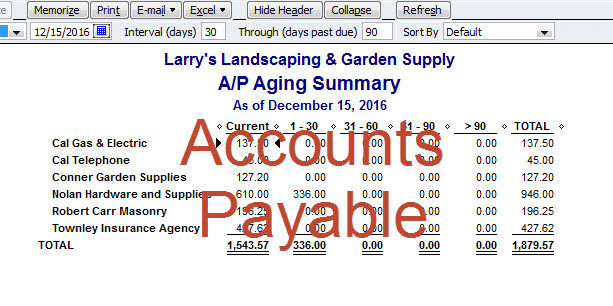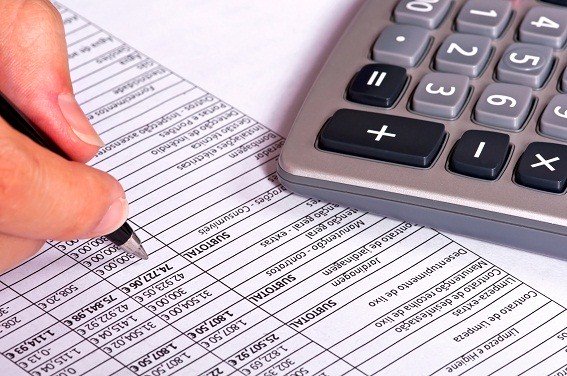- Home
- Bookkeeping Articles
- Calculating Accounts Payable
Calculating Accounts Payable
The Effects on Business Cash Flow
Calculating accounts payable is extremely important for business owners as the nature and the size of their accounts payable could have a dramatic effect on their businesses cash flow.
Accounts payable involves short term liabilities, also known as current liabilities owed to other parties by a business or entity. In many cases suppliers of products or services will allow for a short period after delivery before an invoice is due for payment. This period then creates an accounts payable when the pending charge or cost is tracked in the accounting world.
Calculating Accounts Payable - It's Short-Term Nature
As mentioned above the nature as well as the size of accounts payable is important because they have a direct impact on immediate cash flow. Unlike long-term liabilities such as loans, accounts payable hit and come due usually within 30 to 60 days. And they often involve irregular patterns of charges that don't appear monthly.
Tracking and Display of Accounts Payable
In a very simple accounting system, accounts payable can simply be entered as line item transactions. The system keeps a separate individual ledger behind the scenes for each account and the display shows all of them in aggregate to provide the pressure point of what's owed. If a report is run, however, it will detail the individual ledgers of each account outstanding, and some even provide details on aging so a user can see which accounts are late versus still have time. This stresses the importance of calculating accounts payable on a regular basis.
Calculating Accounts Payable and its Placement in the Balance Sheet Report
As accounts payable are aggregated, this combined short-term liability figure rolls into the overall liabilities figure and categories displayed on the balance sheet report. Accounts payable as a result adds to the liabilities total which is offset to the asset side of the balance sheet report. As the accounts payable figure goes down, it allows for more assets to be available to be used for either long-term liabilities or equity. As the accounts figure increases, however, it eats up more of the asset side of the house, reducing funds available for long-term commitments or equity. This second aspect is why calculating accounts payable is so important. So also is keeping a good handle on the payables side, especially the short-term charges coming due quickly. If not controlled, they can upset the asset picture very quickly.
Calculating Accounts Payable Cash Flow Impact
While not part of the balance sheet, it's important to note that accounts payable also have a significant influence on cash flow and profit and loss statement reports as well. Where a business is cash flow poor, these accounts can create all sorts of headaches, causing a business to have to scramble to pay bills and pulling money from other liabilities and needs. This is why cash flow management is so critical; a business can be asset rich and still have major problems if it doesn't manage the timing of its bills carefully each month.
The income statement impact is obvious as well; as accounts to be paid shortly eat up gross income, operating margins shrink leaving less net cash for the business at the end.
As a result, accounts payable may seem like a small issue as an individual charge, but in total they have a significant impact on the balance sheet as well as other critical accounting reports.
Three Important Factors To Consider
Calculating accounts payable is a crucial aspect of financial management for any business. It involves determining the amount owed to suppliers, vendors, and creditors for goods and services received but not yet paid for. When calculating accounts payable, there are three important factors to consider:
- Accuracy and Timeliness: Accurate and timely calculation of accounts payable is essential to maintain the financial health of a business. It ensures that the company has a clear picture of its outstanding liabilities and can plan its cash flow accordingly. To achieve accuracy, businesses should carefully record and document all invoices, purchase orders, and other relevant documents. It's important to reconcile the accounts payable ledger with vendor statements regularly to identify any discrepancies or missing payments. Timeliness is equally important to avoid late payment penalties and maintain good relationships with suppliers. Promptly calculating and reviewing accounts payable ensures that payments are made on time, helping to foster trust and reliability with suppliers.
- Proper Classification and Categorization: To effectively manage accounts payable, it's crucial to classify and categorize expenses correctly. This helps in tracking and analyzing spending patterns, optimizing cash flow, and making informed financial decisions. Businesses should have a well-organized chart of accounts that appropriately reflects different expense categories and aligns with their industry standards. Accurate classification allows for better financial reporting and analysis, enabling businesses to identify areas of overspending, negotiate better terms with vendors, and implement cost-saving measures.
- Cash Flow Management: Calculating accounts payable plays a significant role in managing cash flow effectively. It's important to evaluate the timing of payments to ensure the availability of sufficient funds when payments are due. Businesses should take into account their payment terms, cash reserves, and upcoming cash inflows when determining the timing of accounts payable. It may be beneficial to negotiate favorable payment terms with suppliers, such as extended payment periods or early payment discounts, to optimize cash flow. Accurate calculation of accounts payable enables businesses to project their cash flow accurately, make informed decisions on managing working capital, and avoid cash flow shortages or excessive borrowing.
In addition to these factors, businesses should implement robust internal controls to safeguard against errors and fraud in the accounts payable process. This includes segregation of duties, regular review of vendor records and payments, and implementing secure payment authorization procedures.
By considering accuracy and timeliness, proper classification and categorization, and effective cash flow management, businesses can ensure the smooth calculation of accounts payable. This, in turn, enables them to maintain healthy relationships with suppliers, optimize cash flow, and make informed financial decisions to support their overall financial well-being.
Accounts Payable Articles
- Accounts Payable Recording Outstanding Bills
- Accounts Payable and the ACA in Santa Rosa
- Accounts Payable and the Self Employment Tax
- Accounts Payable Journal Entries
- Accounts Payable Journal Entries for IRS Audit
- Accounts Payable Petaluma
- Accounts Payable Santa Rosa
- Accounts Payable Affect Cash Flow
- Accounts Payable In Santa Rosa
- Accounts Payable JE's for Growing Businesses
- Accounts Payable Spreadsheet
- Auditing Accounts Payable
- Bookkeeping Services and Accounts Payable
- Calculating Accounts Payable
- Accounts Payable Journal Entry
- Ideal Accounts Payable Turnover
- Improve Accounts Payable Turnover
- Accounts Payable and Minimum Wage Increases
- Streamlining Accounts Payable
Please subscribe to my monthly newsletter, Bookkeeping Basics E-zine. It tells you every month about the new information that I have added, including some great tips and advice from myself and other Bookkeeping Basics readers.
Like Bookkeeping-Basics.net?
- Home
- Bookkeeping Articles
- Calculating Accounts Payable

















New! Comments
Have your say about what you just read! Leave me a comment in the box below.